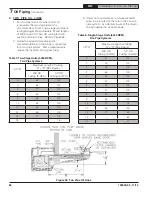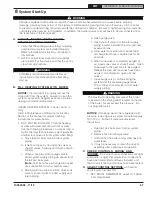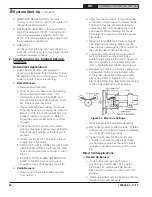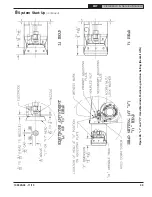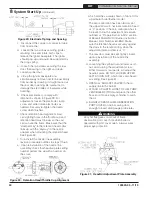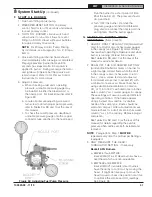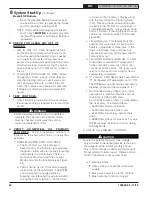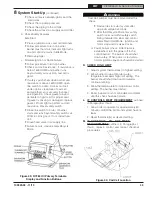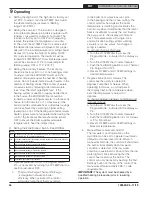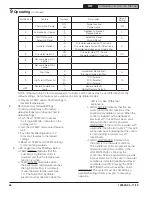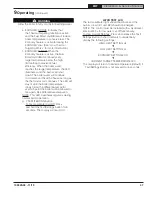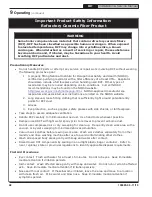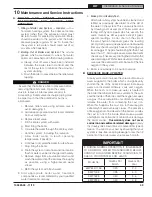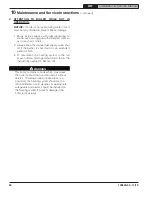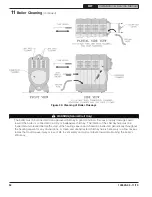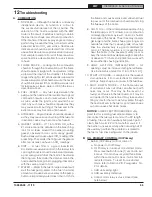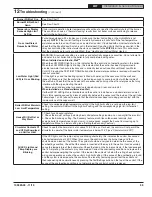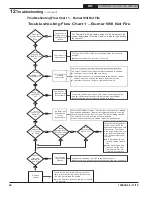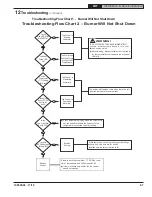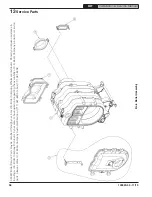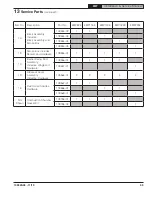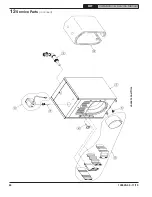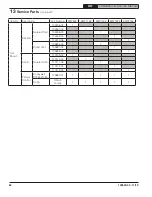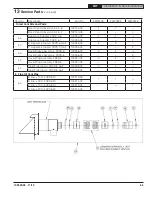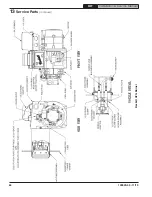
49
EMP
Installation & Service Manual
109529-03 - 11/19
10
Maintenance and Service Instructions
A .
B O I L E R A N D S Y S T E M C L E A N I N G
INSTRUCTIONS FOR TROUBLE FREE
OPERATION
1.
Filling of Boiler and System — General —-
In a
hot water heating system, the boiler and entire
system (other than the expansion tank) must
be full of water for satisfactory operation. Water
should be added to the system until the boiler
pressure gauge registers 12 psi. To insure that
the system is full, water should come out of all
air vents when opened.
2.
Boiling Out of Boiler and System.
The oil and
grease which accumulate in a new hot water
boiler can be washed out in the following manner.
a. Ideally, shut off valves have been installed
between the boiler return manifold and the
rest of the system, to minimize the amount of
system draining.
b. Drain the boiler to a level below the relief valve
tapping.
DANGER
Assure that the boiler is at zero pressure before
removing the relief valve. Open the safety
valve to relieve all internal pressure prior to
proceeding. Safety valve discharge piping must
be piped such that the potential for burns is
eliminated.
c. Remove relief valve using extreme care to
avoid damaging it.
d. Add an appropriate amount of recommended
boil out compound.
e. Replace relief valve.
f. Fill the entire system with water.
g. Start firing the boiler.
h. Circulate the water through the entire system.
i. Vent the system, including the radiation.
j Allow boiler water to reach operating
temperature, if possible.
k. Continue to circulate the water for a few hours.
l. Stop firing the boiler.
m. Drain the system in a manner and to a location
that hot water can be discharged with safety.
n. Remove plugs from all available returns and
wash the water side of the boiler as thoroughly
as possible, using a high-pressure water
stream.
o. Refill the system with fresh water.
3. Add appropriate boiler water treatment
compounds as recommended by your qualified
water treatment company.
4.
Make pH or Alkalinity Test.
After boiler and system have been cleaned and
refilled as previously described, test the pH of
the water in the system. This can easily be done
by drawing a small sample of boiler water and
testing with hydrion paper which is used in the
same manner as litmus paper, except it gives
specific readings. A color chart on the side of
the small hydrion dispenser gives the reading
pH. Hydrion paper is inexpensive and obtainable
from any chemical supply house or through your
local druggist. The pH should be higher than 7 but
lower than 11. Add appropriate water treatment
chemicals, if necessary, to bring the pH within the
specified range. With this lower level of protection,
care must be exercised to eliminate all of the free
oxygen in the system.
5. Boiler is now ready to be put into service.
B .
EXCESSIVE MAKE-UP WATER
A leaky system will increase the volume of make-up
water supplied to the boiler which can significantly
shorten the life of the boiler. Entrained in make-up
water are dissolved minerals, salts and oxygen.
When the fresh, cool make-up water is heated in
the boiler the minerals fall out as sediment, the salts
coat the inside of the boiler, and the oxygen escapes
as a gas. The accumulation of sediment eventually
isolates the water from contacting the cast iron.
When this happens the cast iron in that area gets
extremely hot and eventually cracks. The presence
of free oxygen or chloride salts in the boiler corrodes
the cast iron from the inside. More make-up water
and higher concentrations of contaminants damage
the boiler sooner.
Our warranty does not cover
corrosion and sediment-related damage .
Clearly
it is in everyone's best interest to prevent this type of
failure. You can do your part by ensuring that your
system is leak-free, keeping leakage to less than 2
percent of the boiler water volume each month.
IMPORTANT
IF, DURING NORMAL OPERATION, IT IS NECESSARY
TO ADD MORE WATER THAN INDICATED BELOW,
CONSULT A QUALIFIED SERVICE TECHNICIAN TO
CHECK YOUR SYSTEM FOR LEAKS.
Model No.
Gallons Per
Month
Gallons Per
Year
EMP84E/115E
0.20
2.4
EMP140E
0.25
3.0
EMP182E
0.30
3.6
EMP224E
0.40
4.8
!


